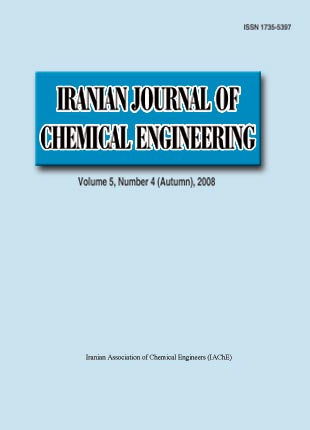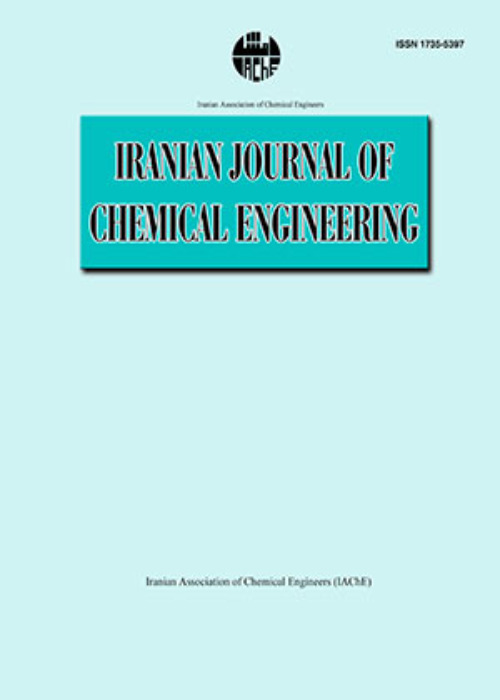فهرست مطالب

Iranian journal of chemical engineering
Volume:5 Issue: 4, Autumn 2008
- تاریخ انتشار: 1387/08/11
- تعداد عناوین: 7
-
-
Page 3Implicit pressure-explicit saturation method (IMPES) is widely used in oil reservoir simulation to study the multiphase flow in porous media. This method has no complexity compared to the fully implicit method, although both of them are based on the finite difference technique. Water coning is one the most important phenomenon that affects the oil production from oil reservoirs having a water drive source. Since the water coning affects final oil recovery, identification of this phenomenon is very important. In order to study this phenomenon, one should determine the critical production rate, the breakthrough time and watercut percentage. The scale of the problem hinders the numerical simulations, IMPES included, for a long running time. A corrected IMPES method is used here to overcome the long running time problem by choosing larger the time step for the coning problem. A water-oil phase flow system in the cylindrical coordinate that is commonly used to simulate water coning phenomenon is solved by the corrected IMPES method. The validity of the model is checked against Aziz and Settari’s model, which is based on a complicated fully implicit method. The effects of the production rate and the thickness of the oil zone on the breakthrough time have been investigated. The results were found to be in good agreement with the results of previous studies.Keywords: Water Coning, Simulation, Oil Reservoirs, IMPES
-
Page 12The turbulent flow field generated in a baffled stirred tank was computed by large eddy simulation (LED) and the flow field was developed using the Sliding Mesh (SM) approach. In this CFD study, mixing times and power number have been determined for a vessel agitated by a 6-blade Rushton turbine. The predicted results were compared with the published experimental data. The satisfactory results of comparisons indicate the potential usefulness of this approach as a computational tool for designing stirred reactors.Keywords: CFD, Stirred tank, Mixing time, Power, LES, MRF
-
Page 23Phenolic acids constitute a major group of pollutants which are recalcitrant to common biological treatment. In this study synthetic wastewater containing a mixture of p-coumaric and p-hydroxybenzoic acids was evaluated for photo-Fenton pretreatment. The changes in biodegradability (ratio of biochemical oxygen demand to total organic carbon (TOC)) and mineralization (TOC removal) were monitored. While there was a significant biodegradability enhancement during the photo-Fenton process, there was little mineralization (less than 6%) taking place over the course of oxidation. Longer oxidation time did not further improve the pretreatment; rather it decreased the biodegradability of the solution through complete mineralization of the biodegradable intermediates. Resin fractionation of treated solutions indicated an increase in the hydrophilic fraction and a decrease in the hydrophobic fraction.
Indeed, there was a clear and direct correlation between the hydrophilic nature of the organics and the biodegradability of the solution, indicating that hydrophilic compounds are more biodegradable. The formation of aldehydes further supported the links between biodegradable and hydrophilic compoundsKeywords: Phenolic compounds, Advanced oxidation processes photo, Fenton, Biodegradability -
Page 33Membrane technology is one of the few non-pollutant choices when selecting a treatment process. A membrane with suitable pore size can remove almost all pollutants without using any chemicals. In this research, chromium, zinc and lead were removed from synthetic wastewater by a membrane bioreactor. The results showed that by using a membrane bioreactor, the COD removal efficiency was increased in all conditions in comparison with that of an activated sludge process system. According to the test results, in the case of having heavy metals; Chromium with a concentration below 50 mg/l , the removal efficiency was shown to be about 95% and at these concentrations, chromium has no toxic effect on micro-organisms. However, the Activated Sludge Process showed poor removal efficiency in the case of having zinc. But when ASP was used in conjunction with the membrane, the removal efficiency was increased to 76%. Membrane showed an improvement of efficiency from 44% to 65% in the case of having 50 mg/ l of lead.Keywords: Membrane bioreactor, Heavy metals, Wastewater treatment
-
Page 39The UNIQUAC activity coefficient model is extended to predict solid-liquid equilibrium of isotactic crystalline poly (1-butene), iPBu-1, in different organic solvents. The UNIQUAC activity coefficient model used in this work is based on the concept of group contribution and consists of combinatorial, residual and free volume terms. To account for branching of atom groups in the monomer structure of the polymer, a correction factor has been applied to the surface parameter of combinatorial and residual terms. Use of this correction factor has significantly improved the accuracy of the model and shows that the proposed activity coefficient model is a proper model for solid-liquid equilibrium calculation in polymer solutions.Keywords: UNIQUAC model, Solid, liquid equilibria, IPBu, 1, Polymer solutions, Free
-
Page 49The optimization of adsorption-based operations requires an accurate model to represent the separation process. In the present study, single-component adsorption data of L-lysine on its imprinted polymer were fitted to Freundlich, Langmuir-type and Jovanovic-type models. L-Lysine imprinted polymer (LLIP) was prepared by free radical solution polymerization. The best estimate of the parameters of these models by regression analysis was obtained. The statistical analysis of results showed that the experimental data fit the Jovanovic-Freundlich mode, better than other models in terms of f value. The best prediction of retention capacity equal to 0.186 mmol lysine per g of LLIP, which is the nearest value to the experimental data, was obtained by applying the Jovanovic model.Keywords: Molecular imprinting, Isotherm model, Jovanovic, Freundlich, Lysine adsorption
-
Notes for AuthorsPage 56


